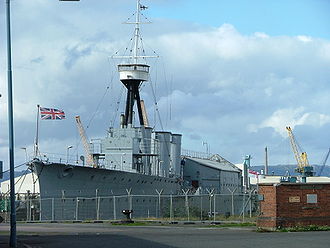- HMS Caroline (1914)
-

Geschichte 
Kiellegung: 28. Januar 1914 Stapellauf: 29. September 1914 Indienststellung: 4. Dezember 1914 Außerdienstellung: 31. März 2011 Daten Verdrängung: Normal: 4219 ts
Maximal: 4733 tsLänge: 135,9 m Breite: 12,6 m Tiefgang: 4,9 m Antrieb: - 8 Yarrow-Kessel
- 2 x Parsons-Dampfturbinen mit je 20.000 PS auf 4 Wellen
Geschwindigkeit: 28,5 Knoten Bunkermenge: 916 t Heizöl Reichweite: 5.900 Seemeilen bei 10 Knoten Besatzung: 301 Bewaffnung
(heute entfernt):- 2 x 6"/45 BL Mk VII[A 1]
(152 mm Geschütze) - 8 x 4"/45 QF HA Mk V[A 2]
(102 mm Geschütze) - 4 x 3-pdr/50 QF
(47 mm Geschütze) - 8 x 21" (533 mm) Torpedorohre
Panzerung: Gürtel: 1-3 in (25,4-76,2 mm)
Deck: 1 in (25,4 mm)
Kommandoturm: 6 in (152 mm)Die HMS Caroline war ein Leichter Kreuzer der britischen Marine und diente bis 2011 als Trainingsschiff in Belfast. Sie ist das letzte erhaltene Kriegsschiff, das an der Skagerrakschlacht beteiligt war. Nach ihrer Ausmusterung wurde sie vom National Museum of the Royal Navy übernommen.
Geschichte
Die Caroline wurde bei Cammell, Laird & Company in Birkenhead innerhalb von nur neun Monaten gebaut und am 4. Dezember 1914 als erstes Schiff ihrer Klasse offiziell in Dienst gestellt. Während des Ersten Weltkriegs war sie mit der Grand Fleet in der Nordsee im Einsatz und nahm 1916 an der Skagerrakschlacht teil. Ab 1918 war sie in Aden stationiert und operierte im Indischen Ozean. 1924 wurde die Caroline zum Trainingsschiff der Marinereserve umfunktioniert und in Belfast vertäut, wobei die Bewaffnung entfernt wurde.
Am 1. Dezember 2009 wurde die Royal Naval Reserve Unit HMS Caroline offiziell aufgelöst und gleichzeitig als Royal Naval Reserve Unit HMS Hibernia in den Thiepval Barracks in Lisburn neu gegründet. Im Juli 2009 gab das Verteidigungsministerium bekannt, dass Gespräche mit dem Marinemuseum in Portsmouth aufgenommen wurden, um die HMS Caroline dort unterzubringen.[1] Der Kommandant der HMS Caroline erklärte jedoch im Dezember 2009, dass die Royal Navy es bevorzugen würde, das Schiff in Belfast zu belassen.[2]
Die HMS Caroline wurde am 31. März 2011 offiziell außer Dienst gestellt und an das National Museum of the Royal Navy übergeben. Sie soll langfristig als Museumsschiff erhalten bleiben, die Standortfrage ist jedoch weiterhin ungeklärt.[3] Zum Zeitpunkt ihrer Ausmusterung war die Caroline nach der HMS Victory das älteste aktive Kriegsschiff der Royal Navy und nach der HMS Victory und der USS Constitution das drittälteste weltweit.
Anmerkungen
- ↑ BL ist die Abkürzung für "breech loader" und bedeutet, dass es sich um einen Hinterlader mit gezogenem Rohr handelt. Jedoch anders als beim QF mit von der Granate getrennter Treibladung.
- ↑ QF ist die Abkürzung für "quick fire" und bedeutet, dass Granate und Kartusche miteinander verbunden waren, was die Ladezeit verkürzte. HA steht für "high angle" und bedeutet, dass ein solches Geschütz auf einer hohen Sockellafette montiert ist und dadurch auch (zur Flugabwehr) in einen steilen Winkel gerichtet werden kann.
Einzelnachweise
- ↑ HMS Caroline plans afoot, Belfast Telegraph. 18. August 2009.
- ↑ Battle of Jutland veteran HMS Caroline to stay in Belfast, Belfast Telegraph. 1. Dezember 2009.
- ↑ HMS Caroline options considered by Royal Navy museum, BBC. 13. April 2011.
Wikimedia Foundation.
